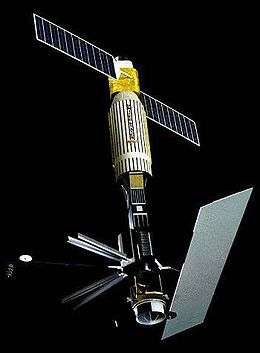Seasat
 Seasat | |
| Mission type | Oceanography |
|---|---|
| Operator | NASA / JPL / Caltech |
| COSPAR ID | 1978-064A |
| SATCAT no. | 10967 |
| Mission duration | 105 days achieved |
| Spacecraft properties | |
| Bus | Agena-D |
| Manufacturer |
Lockheed Ball Aerospace JPL |
| Launch mass | 1,800 kilograms (4,000 lb) |
| Start of mission | |
| Launch date | 28 June 1978, 01:12:00 UTC |
| Rocket | Atlas E/F Agena-D |
| Launch site | Vandenberg SLC-3W |
| End of mission | |
| Last contact | 10 October 1978 |
| Orbital parameters | |
| Reference system | Geocentric |
| Regime | Sun-synchronous |
| Eccentricity | 0.00209 |
| Perigee | 769.0 kilometers (477.8 mi) |
| Apogee | 799.0 kilometers (496.5 mi) |
| Inclination | 108.0 degrees |
| Period | 100.7 minutes |
Seasat[1] was the first Earth-orbiting satellite designed for remote sensing of the Earth's oceans and had on board the first spaceborne synthetic aperture radar (SAR). The mission was designed to demonstrate the feasibility of global satellite monitoring of oceanographic phenomena and to help determine the requirements for an operational ocean remote sensing satellite system. Specific objectives were to collect data on sea-surface winds, sea-surface temperatures, wave heights, internal waves, atmospheric water, sea ice features and ocean topography. Seasat was managed by NASA's Jet Propulsion Laboratory and was launched on 27 June 1978[2] into a nearly circular 800 km orbit with an inclination of 108°. Seasat operated for 106 [3] days until 10 October 1978, when a massive short circuit in the satellite's electrical system ended the mission.
Seasat carried five major instruments designed to return the maximum information from ocean surfaces:
- Radar altimeter to measure spacecraft height above the ocean surface
- Microwave scatterometer to measure wind speed and direction
- Scanning multichannel microwave radiometer to measure sea surface temperature
- Visible and infrared radiometer to identify cloud, land and water features
- Synthetic Aperture Radar (SAR) L-band, HH polarization, fixed look angle to monitor the global surface wave field and polar sea ice conditions {the antenna is the light parallelogram in the picture}. The SAR support structure was designed and manufactured by Northrop Grumman Astro Aerospace in Carpinteria, CA. The structure deployed on orbit.
Many later remote sensing missions owe their legacy to Seasat. These include imaging radars flown on NASA's Space Shuttle, altimeters on Earth-orbiting satellites such as TOPEX/Poseidon, and scatterometers on NASA Scatterometer (NSCAT), QuikSCAT, and Jason 1.
Seasat SAR data released in 2013
On the 35th anniversary of Seasat's launch, the Alaska Satellite Facility released newly digitized Seasat synthetic aperture radar (SAR) imagery.[4] Until this release, Seasat SAR data were archived on magnetic tapes, and images processed from the tapes were available only as optical images of film strips or scanned digital images. Neither the tapes nor the film allow the quantitative analysis possible with the new digital archive.[5][6]
Conspiracy theory
Seasat was able to detect the wakes of submerged submarines, a discovery not anticipated before launch.[7] The conspiracy theory holds that once this was discovered, the military shut SEASAT down, with a cover story of a power supply short.[8][9]
References
- ↑ "Seasat: Short Description". NASA Jet Propulsion Laboratory. Retrieved 28 June 2013.
- ↑ https://science.nasa.gov/missions/seasat-1/
- ↑ "Past Missions - Seasat". NASA Jet Propulsion Laboratory. Retrieved 28 June 2013.
- ↑ "Trailblazer Sea Satellite Marks Its Coral Anniversary". NASA Jet Propulsion Laboratory. Retrieved 28 June 2013.
- ↑ Rettig, Molly (2013-06-22). "Old satellite imagery offers new baseline data". Anchorage Daily News. Retrieved 28 June 2013.
- ↑ "Alaska Satellite Facility Celebrates Seasat 35th Anniversary". University of Alaska Fairbanks. Retrieved 28 June 2013.
- ↑ WILLIAM J. BROAD (11 May 1999). "U.S. Loses Hold on Submarine-Exposing Radar Technique". New York Times.
- ↑ Pat Norris (2008). Spies in the Sky Surveillance Satellites in War and Peace. Praxis. ISBN 978-0-387-71672-5. doi:10.1007/978-0-387-71673-2. p. 172
- ↑ "The Ship Model Forum". Retrieved 2008-11-18.
Further reading
- Science, vol. 204, No. 4400, 29 June 1979, cover and papers pp. 1405–1424.
- IEEE Journal on Oceanic Engineering, vol. OE-5, no. 2, April 1980, Special Issue on SEASAT-1 Sensors.
- Charles Elachi, "Spaceborne Imaging Radar: Geologic and Oceanographic Applications," Science, vol. 209, No. 4461, 5 September 1980, pp. 1073–1082.
External links
- JPL Seasat page
- Seasat Views Ocean and Sea Ice with Synthetic Aperture Radar
- SEASAT II, JSR-83-203, March 1984
- SEASAT III & IV, JSR-84-203, August 1984
- ASF Seasat portal, June 2013
- ASF about Seasat, June 2013
- ASF Data Download, June 2013
| Wikimedia Commons has media related to Seasat. |